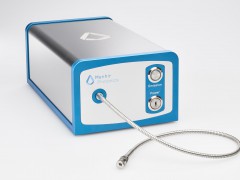
Laser Diodes in Sensor Detect Quality Differences in Olive Oils
source:Photonics
release:Nick
Time:2018-12-28
Researchers at the Complutense University of Madrid (UCM) and the Scintillon Institute have designed a sensor that can detect counterfeit olive oil labeled as extra virgin or protected designation of origin. Laser diodes in the sensor detect
fluorescence
levels in the oils, which differ slightly between the adulterated and pure extra virgin olive oils.
To test the system, over 450 binary blends composed of protected designation of origin extra virgin olive oil (PDO EVOO) in date were adulterated with expired PDO EVOO and analyzed using fluorescence spectroscopy . The researchers measured the fluorescence emission of each sample using a laser diode as a source light and calculated 20 chaotic parameters from the resulting spectra. They quantified the concentration of adulterant using chaotic-based regression models. The researchers validated their approach according to the leave-one-out cross-validation method. The results were promising (lower than 10 percent quantification error).

The sensor could provide inexpensive quality control and adulteration detection for PDO EVOO. “This technique is available for use at any time, and only requires oils prior to packaging for quality control or after packaging to detect fraudulent brands and/or producers,” Torrecilla said.
To test the system, over 450 binary blends composed of protected designation of origin extra virgin olive oil (PDO EVOO) in date were adulterated with expired PDO EVOO and analyzed using fluorescence spectroscopy . The researchers measured the fluorescence emission of each sample using a laser diode as a source light and calculated 20 chaotic parameters from the resulting spectra. They quantified the concentration of adulterant using chaotic-based regression models. The researchers validated their approach according to the leave-one-out cross-validation method. The results were promising (lower than 10 percent quantification error).

The sensor can distinguish between apparently similar oils. Courtesy of Esencia Andalusí.
The sensor could provide inexpensive quality control and adulteration detection for PDO EVOO. “This technique is available for use at any time, and only requires oils prior to packaging for quality control or after packaging to detect fraudulent brands and/or producers,” Torrecilla said.
MOST READ
- RoboSense is to Produce the First Chinese Multi-beam LiDAR
- China is to Accelerate the Development of Laser Hardening Application
- Han’s Laser Buys Canadian Fiber Specialist CorActive
- SPI Lasers continues it expansion in China, appointing a dedicated Sales Director
- Laser Coating Removal Robot for Aircraft
PRODUCTS
 FISBA exhibits Customized Solutions for Minimally Invasive Medical Endoscopic Devices at COMPAMED in
FISBA exhibits Customized Solutions for Minimally Invasive Medical Endoscopic Devices at COMPAMED in New Active Alignment System for the Coupling of Photonic Structures to Fiber Arrays
New Active Alignment System for the Coupling of Photonic Structures to Fiber Arrays A new industrial compression module by Amplitude
A new industrial compression module by Amplitude Menhir Photonics Introduces the MENHIR-1550 The Industry's First Turnkey Femtosecond Laser of
Menhir Photonics Introduces the MENHIR-1550 The Industry's First Turnkey Femtosecond Laser of Shenzhen DNE Laser introduced new generation D-FAST cutting machine (12000 W)
more>>
Shenzhen DNE Laser introduced new generation D-FAST cutting machine (12000 W)
more>>





